

Russia says it may abandon Space Station by 2020 over Ukraine conflict. From black holes to dark matter, an astrophysicist explains. Katherine Mack, astrophysicist at the University of Melbourne, answered questions posed by the public on Reddit.

The Conversation has curated the highlights. Dark Matter How do you explain dark matter to kids? I tell them that when they touch the table, what they are feeling is the electromagnetic repulsion (or, you know, I use some less jargony way of saying that) between that surface and their hand, and that is what makes it feel solid and what keeps you from passing right through it. Dark matter doesn’t seem to have that force. Do we have evidence for dark matter? Nnedi Okorafor's Lagoon Shows Just How Messy First Contact Could Get. Are Religious Beliefs Going To Screw Up First Contact? Habitable exoplanets are bad news for humanity.
Last week, scientists announced the discovery of Kepler-186f, a planet 492 light years away in the Cygnus constellation.
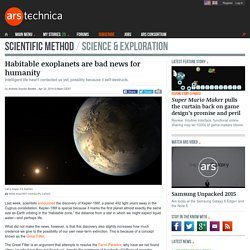
The Great Filter. Sept. 15, 1998 by Robin Hanson Humanity seems to have a bright future, i.e., a non-trivial chance of expanding to fill the universe with lasting life.
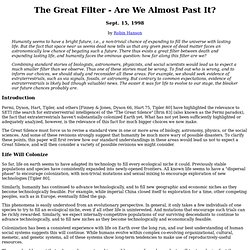
But the fact that space near us seems dead now tells us that any given piece of dead matter faces an astronomically low chance of begating such a future. There thus exists a great filter between death and expanding lasting life, and humanity faces the ominous question: how far along this filter are we? Combining standard stories of biologists, astronomers, physicists, and social scientists would lead us to expect a much smaller filter than we observe. Future - Will nuclear-powered spaceships take us to the stars? In the 1950s, rocket scientists dreamed of atomic-powered spaceships.

Now these far-fetched designs might help a new generation explore the cosmos. Project Orion has to be the most audacious, dangerous and downright absurd space programme ever funded by the US taxpayer. This 1950s design involved exploding nuclear bombs behind a spacecraft the size of the Empire State Building to propel it through space. The Orion’s engine would generate enormous amounts of energy – and with it lethal doses of radiation. Plans suggested the spacecraft could take off from Earth and travel to Mars and back in just three months. Hundreds of Exoplanets, A Handful Right for Life. Of the 1,780 confirmed planets beyond our solar system, as many as 16 are located in their star’s habitable zone, where conditions are neither too hot nor too cold to support life.
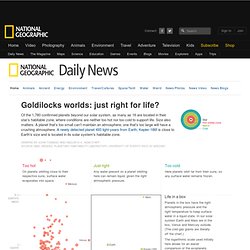
Size also matters: A planet that’s too small can’t maintain an atmosphere; one that’s too large will have a crushing atmosphere. A newly detected planet 493 light-years from Earth, Kepler-186f is close to Earth's size and is located in its solar system's habitable zone. Graphic by John Tomanio and Xaquín G.V., NGM staff.Source: Abel Méndez, Planetary Habitability Laboratory, University of Puerto Rico at Arecibo Star Hot orbital zone Warm.
All The Kepler Planets Graphed By Their Ability To Support Life. First Extraterrestrial Waves Ever Spotted On Titan. Saturn’s largest moon, Titan, looks a lot like Earth, except in deepfreeze.
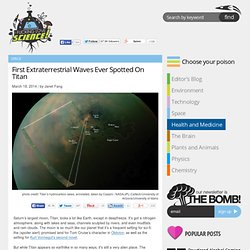
It’s got a nitrogen atmosphere, along with lakes and seas, channels sculpted by rivers, and even mudflats and rain clouds. The moon is so much like our planet that it’s a frequent setting for sci-fi: the (spoiler alert) promised land for Tom Cruise’s character in Oblivion, as well as the setting for Kurt Vonnegut’s second novel. But while Titan appears so earthlike in so many ways, it's still a very alien place.
The moon’s lakes and seas are not made of H2O -- at minus 290 degrees Fahrenheit, Titan’s surface is way too cold for liquid water. The giant doughnuts that could help a Mars landing. Hurtling towards Mars and don’t know how to stop?
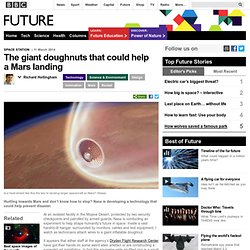
Nasa is developing a technology that could help prevent disaster. At an isolated facility in the Mojave Desert, protected by two security checkpoints and patrolled by armed guards, Nasa is conducting an experiment to help shape humanity’s future in space. Inside a vast harshly-lit hangar, surrounded by monitors, cables and test equipment, I watch as technicians attach wires to a giant inflatable doughnut. It appears that either staff at the agency’s Dryden Flight Research Center have got their hands on some weird alien artefact or are constructing a surrealist art installation.
Getting the math of the Universe to cancel out. The vacuum of space isn't actually "empty"; it teems with particles that pop in and out of existence, giving the vacuum an energy of its own.
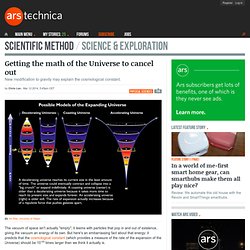
But here's an embarrassing fact about that energy: it predicts that the cosmological constant (which provides a measure of the rate of the expansion of the Universe) should be 10120 times larger than we think it actually is. Most scientists prefer things to be a bit more accurate than this. Still, the main question on cosmologists' minds is not why the predicted and real values appear to be so different, but how it is that the vacuum energy does so little. An answer of sorts has recently appeared in Physical Review Letters. Getting the math of the Universe to cancel out. Space elevator. A space elevator for Earth would consist of a cable fixed to the Earth's equator, reaching into space.
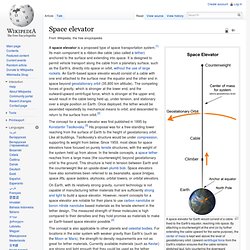
By attaching a counterweight at the end (or by further extending the cable upward for the same purpose), the center of mass is kept well above the level of geostationary orbit. Upward centrifugal force from the Earth's rotation ensures that the cable remains stretched taut, fully countering the downward gravitational pull. Space Elevators. Science Deck - Space Elevators. This book addresses the simple and complex issues that have been identified through the development of space elevator concepts over the last decade.
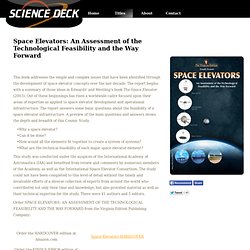
The report begins with a summary of those ideas in Edwards' and Westling's book The Space Elevator (2003). Out of these beginnings has risen a worldwide cadre focused upon their areas of expertise as applied to space elevator development and operational infrastructure. Space Elevators Are Totally Possible (and Will Make Rockets Seem Dumb) It's the scourge of futurists everywhere: The space elevator can't seem to shake its image as something that's just ridiculous, laughed off as the stuff of sci-fi novels and overactive imaginations.
But there are plenty of scientists who take the idea quite seriously, and they’re trying to buck that perception. To that end, a diverse group of experts at the behest of the International Academy of Astronautics completed an impressively thorough study this month on whether building a space elevator is doable. Their resulting report, "Space Elevators: An Assessment of the Technological Feasibility and the Way Forward," found that, in a nutshell, such a contraption is both totally feasible and a really smart idea.
And they laid out a 300-page roadmap detailing how to make it happen. RELATED: The Twelve Mile High Tower Is on "Pause" Thanks to the Jet Stream. Lunar Map Catalog. NASA's Buckminster Fuller-inspired Super Ball Bot. Buckminster Fuller would be proud of NASA's new experimental robot design. It's based on the structural principle that Fuller called tensegrity (tensional integrity) where the structure comes from compressed rods and flexible connections. NASA calls their prototype the Super Ball Bot for its ability to bounce on landing and shift its shape via multiple small motors to roll across a surface.
IEEE Spectrum's video about the project is below. More information at NASA's page here and in this Wired Design article. And just for kicks, here's a recent Buckminster Fuller tribute I wrote for LIFE. Imagine.gsfc.nasa.gov/docs/teachers/lifecycles/Imagine2.pdf. Www.searchanddiscovery.com/documents/halbouty/images/halbouty.pdf. What is the universe made of? - Dennis Wildfogel. 19g6gf916lxofjpg.jpg (1885×3044) How would humanity change if we knew aliens existed? Big Pic: The Solar System's Largest Moon, Mapped. How Many People Are In Space Right Now? Star Sand. Jewel Box Sun. Scientists at work: living on a simulated Mars. According to Martin Rees, the Astronomer Royal, establishing a permanent presence beyond Earth is the first step humans will take towards the “divergence into a new species”. Plans to visit and even colonise Mars are no longer the subject of science fiction novels.
But before we can do that, we need to understand how humans can survive and thrive on Mars. Overview - Finding Our Place in the Cosmos: From Galileo to Sagan and Beyond. Overview Like our ancestors, we look up at the heavens and wonder. What is the structure of the universe? How significant are we? Are we alone? In Carl Sagan’s words, “we are a way for the cosmos to know itself.”
This online collection includes three primary sections. How Rosetta wakes up from deep space hibernation. How fast are you moving right now? - Tucker Hiatt. Opportunity: 10 Years on Mars - Operating A Rover. Opportunity: 10 Years on Mars - Operating A Rover. Relief as Rosetta wakes, but we continue to hold our breath. As one of the scientists involved in the Rosetta mission, news that the unmanned spacecraft has woken up and restored contact with Earth comes as a great relief. It contains an instrument I first began designing while working on my PhD—a project in which I have invested more than 20 years. It was on January 14, 1993 that I drew some sketches of a concept for an instrument that could be sent to a comet. [1401.3741] Enduring Quests-Daring Visions (NASA Astrophysics in the Next Three Decades) Enduring Quests and Daring Visions: NASA Lays Out a Roadmap for Astrophysics. No Edge: The Shape of the Universe. (Part 1: Flat Models) No Edge: The Shape of the Universe. (Part 1: Flat Models)
What do we mean when we say the Universe is curved? New Survey Supports the Theory that the Universe Is Infinite. New Survey Supports the Theory that the Universe Is Infinite. Circumstellar habitable zones for deep terrestrial biospheres. New study dramatically changes where we believe aliens might live. Astronomers may have just discovered a new class of planets. This spidery spacecraft will be the first to soft-land on a comet.
Vytas SunSpiral. NASA's New Robot Prototype Looks Like a Pile of Drunk Sticks. NASA’s SuperBall Bot is no WALL-E.While something like the Mars Curiosity Rover is cute, all spindly legs and easily anthropomorphizable camera eyes, the SuperBall is decidedly not. It looks like a broken tent, or a pile of twigs who had too much tequila to drink. Developed by Adrian Agogino and Vytas SunSpiral (!!!) Mars Wear and Tear: Curiosity's Wheel Damage: Photos. Before - Sept. 9, 2012 (Sol 34) Meet the Kraken: Hydrocarbon seas spotted at Titan’s north pole. The joint NASA-ESA Cassini space probe, exploring Saturn and its moons, has revealed extraordinary lakes and seas of liquid methane around the north pole of Saturnian moon Titan.
China has landed on the Moon. The World Outside My Window - Time Lapse of Earth from the ISS (4K) NASA's hovering lander looked beautiful at yesterday's test-launch. Fuel is cheap, $10,000 in fuel vs. $50,000,000 one use item. Actually, yes. India, China send probes out of this world. Over the weekend, two separate pieces of hardware left Earth for other worlds. Sphère de Dyson. Un article de Wikipédia, l'encyclopédie libre. Future Spacecraft Will Be 3-D Printed. A first-hand account of the launch of NASA’s LADEE lunar probe. Public maps out an A to Z of galaxies. BOLIDES - Visualizing meteorites. Fireball from Outer Space. Press Release - Blue Light Observations Indicate Water-Rich Atmosphere of a Super-Earth - Subaru Telescope. The Moon in 1910. British university posts exclusive photo scans of space exploration artifacts. The 2 Secrets to Sending People to Mars. The 20 big questions in science. Sun Primer: Why NASA Scientists Observe the Sun in Different Wavelengths.
Solar Palette If you look at the Sun (which you. Engineers Identify 12 Asteroids We Could Capture With Existing Rocket Technology - Wired Science. Keeping a Record of Our Burning Planet. Star Trails: Incredible Long Exposure Photographs Shot from Space. Scientists are arguing about whether Voyager has left the Solar System.
Almost orbital, solar-powered drone offered as “atmospheric satellite” Could We Stop An Asteroid? Feat. Bill Nye. Ars hops in Boeing’s “commercial space” spaceship, the CST-100. Roswell & New Signals from Space. Hanny's Voorwerp - Sixty Symbols. Build a Solar System Model. Build a Solar System Model. European Space Agency Reveals New Rocket Design. Astronomers watch gas streaming into a massive embryonic star. Newly Discovered Planet Has Glass Rain and 4,500 MPH Wind. How To Clean Up Space Junk.
How To Clean Up Space Junk. Planétarium. Mysterious radio bursts come from outside our galaxy. Last transmitter dies, finalizing retirement for ocean-sensing satellite. Wildfires Smoke Crosses the Atlantic. Galerie de FEI Company. Interstellar gas allows chemical reactions caused by quantum tunneling. The James Webb Space Telescope. Découverte de trois exoplanètes potentiellement habitables.
Galaxy Zoo. Scale. Cassini captures gigantic hurricane on Saturn in exquisite detail. Laser propulsion. Iron in Egyptian relics came from space. Does the Big Bang necessarily mean we’re part of a multiverse? Kickstarting a Space Telescope?! Willamette Meteorite. How It Works: NASA’s Curiosity Mars Rover.